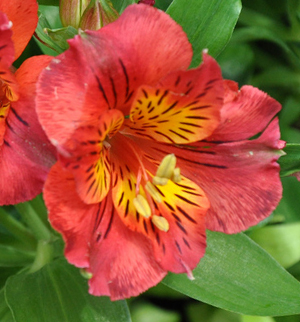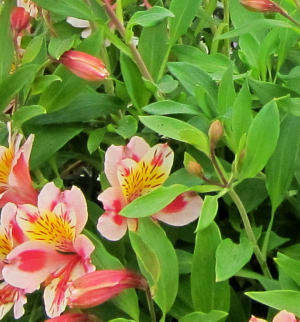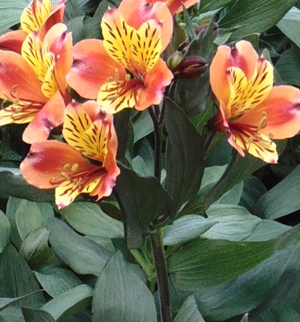Alstromerium family. Homeland - subtropics of South America (Chile, Brazil, Peru). There are about 60 species in nature.
The name of the genus was given by Karl Linnaeus in honor of the Vedic naturalist and botanist Klas Alströmer. When pronouncing the name of this flower, the sound "yo" should sound - according to the historical pronunciation. But we Russians do not like to break the tongue, and often in the name of the plant sounds the letter "o" - Alstromeria.



These are herbaceous rhizome perennials. The roots have tuberous spindle-shaped outgrowths. The stems are erect, bushes grown in open ground can reach more than 1.5 m and require a garter to the support. Shoots are of two types: vegetative, on which only leaves develop, and reproductive, bearing peduncles. The leaves are alternate light green in color, linear in shape, slightly wavy. The generic feature of this plant is leaf resupination. The petiole of the leaf, or rather even the petiole-shaped lower part of the leaf (petioles are practically not expressed) is twisted 180 °, and at the same time that part of the leaf that is lower is located upward, and vice versa, the upper part of the leaf "looks" down. Umbrella inflorescences carry 10-20 zygomorphic flowers, very similar to orchid flowers. The calyx of the flower is formed by six petals arranged in two circles of three. The fruit is a box, like a poppy.
At home or as a greenhouse plant, as well as for cutting, they grow mainly not species alstroemeria, but hybrid ones. They are distinguished by a wide variety of colors - orange, yellow, red, pink, purple, lavender, salmon and white, in general, of all colors except true blue.
Alstroemeria can be grown as garden plants. To do this, ask for seeds of cold-resistant hybrids, for example, "Funny Moths." In the southern regions of Russia, it is grown all year round in open ground, only closing it with lapnik for the winter. In central Russia, in October, it is dug up and stored in a cellar (in the ground in small pots) along with other garden flowers, for example, dahlias.
Alstroemeria care at home
Temperature
Prefers moderate temperatures. In summer, the usual indoor, but optimally about 20-22 ° C, in winter about 13-15 ° C, at least 8 ° C, despite the fact that species alstroemeria can withstand even small frosts, hybrid plants sold in stores are not so frost-resistant. But they all dislike the heat equally. At temperatures above 28 ° C, the plant freezes in growth, quickly discards flowers, wilts. Too high a temperature of alstroemeria in winter prevents the laying of flower buds, and the plant may not bloom.
Lighting
Alstroemeria loves light, it cannot be attributed to shade-tolerant plants, but if in autumn and winter it can be kept on the south window, then in spring and summer it is necessary to shade at noon (i.e. partially direct sun, partially bright scattered light). For successful flowering, the duration of daylight hours must be at least 13-14 hours. Therefore, they use additional illumination for it using fluorescent lamps.
Watering
In spring and summer, moderate, the soil should have time to dry out. In winter, watering is limited, depending on the temperature. Alstroemeria does not tolerate stagnation of water in the roots, excessive watering, but it is also impossible to allow strong overfilling of the earth. During the growing season, ideally, watering should be such that the soil is constantly in a slightly moist state. Watering water is used only soft.
Fertilizer
Alstroemeria does not tolerate large doses of nitrogen in fertilizers, so use only fertilizers for ornamental flowering plants, for example, Fertica (NPK 16-20.6-27.1) or for bulbous ones - Fasco Onion (NPK 7-9-12), Etisso (NPK 3.8-7.6-7.5), etc.
Air humidity
If the air temperature is moderate, then the plant does not require spraying the leaves. On hot days in summer, you can spray with warm water in the morning or evening.
Flight connections
Potted alstroemeria are transplanted annually in the spring. Their root system is quite powerful. Soil mixture: 2 parts of leafy land, 1 part of peat, 1 part of humus land and 1 part of perlite, 1 part of pine bark. pH is slightly acidic and acidic (preferably pH = 5-5.5), alstroemeria does not tolerate alkaline soils. Soil can be used for azaleas and rhododendrons. Good drainage at the bottom of the pot is a must.
Reproduction
Seeds or division of the rhizome. Seeds are sown in February, in slightly moistened peat soil and stratified at a temperature of 2-4 ° C for 1-2 months, then the temperature is gradually increased to 20-25 ° C. As soon as shoots appear, you need to provide them with good lighting, regularly ventilate the greenhouse, for 30 minutes 2-3 times a day. With the growth of seedlings, greenhouse shelter or glass is gradually removed from the plates, accustoming young plants to drier air.
Diseases and pests of alstroemeria
Most often, thrips harm the plant, and when kept in warm or hot conditions, ticks.
Thrips hide in buds and flowers, they are difficult to detect on variegated petals, and puncture marks, highlighted silver spots and strokes are clearly visible on the leaves. The easiest way to deal with thrips is with systemic insecticides - actara or confidor, watering the soil.
Of the diseases, the most serious are root rot, phytophthora, fusariosis - from excess moisture in the soil and stagnation of water, as well as gray rot - it appears as a result of increased humidity and poor ventilation of the premises. Be sure to sterilize the garden land before transplanting or sowing.

